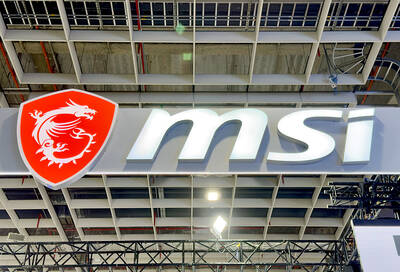A port in Pakistan’s Gwadar is a linchpin in China’s plan to revive the old Silk Road linking Asia to Europe and Africa, but a slow Internet line is causing it to lose business.
The customs authority’s failure to fully address issues with Internet speed and reliability has meant the port, operated by a Chinese state-owned company, is functioning at less than capacity, Gwadar Port Authority chairman Dostain Khan Jamaldini said in an interview.
“About four cargoes of sea food go daily from here to Karachi,” Jamaldini said, referring to the jetty next to the port where customs clearance is done manually. “We are not proactive, we are reactive. It’s a systematic flaw.”

Photo: Bloomberg
The deep-sea port in Pakistan represents a geopolitical tension point with neighboring arch-rival India, which is financing an Iranian port about 76 nautical miles (140km) away. India sent its first wheat consignment to Afghanistan through Iran’s Chabahar port in October.
The customs authority’s online system is riddled by delays due to a slow Internet connection and an alternative wireless system installed by the Chinese is facing similar bandwidth problems, Jamaldini said.
Jamaldini feels time is of essence, as Gwadar is better positioned geographically and economically for trade with Afghanistan .
“Chabahar port does not have that potential, the route is longer and more expensive,” he said, adding that “state policy can force traders temporarily, but not forever, they will work where they make more money.”
What used to be a small fishing town on the southwestern corner of Pakistan is giving way for construction of roads and buildings to house banks, insurance and clearing agents. China Overseas Port Holdings Ltd (中國海外港口控股), the port’s operator, has separately spent US$250 million to add five new cranes, construct a building in less than six months by importing ready made parts and create space for a free zone.
Five manufacturers have signed agreements to build factories at the economic free zone, including for electric motorcycles, edible oil and a fish processing plant, Jamaldini said.
China is making a big bet on Pakistan and Beijing’s financing has brought power plants and infrastructure projects valued at about US$60 billion.
The nation’s economic growth rose to the highest in more than a decade and power blackouts have been curbed, helping trigger a wave of expansion in cement and steel companies.
However, the increased imports has also lead to Pakistan’s current financial deterioration, with a current-account deficit that has increased by 45 percent to US$16 billion in 11 months ended May.
There are also concerns over the viability of the port itself.
Gwadar “can potentially serve a role to provide additional port capacity for Pakistan itself, for Afghanistan, as a complement and transshipment hub for Chabahar, as a location for the Chinese to ship materials and so on,” said Andrew Small, a senior fellow at the German Marshall Fund of the US and an author of a book on China-Pakistan relations.
It “isn’t really envisaged as the beginning or end of a transit route for China,” he said.

Meta Platforms Inc offered US$100 million bonuses to OpenAI employees in an unsuccessful bid to poach the ChatGPT maker’s talent and strengthen its own generative artificial intelligence (AI) teams, OpenAI CEO Sam Altman has said. Facebook’s parent company — a competitor of OpenAI — also offered “giant” annual salaries exceeding US$100 million to OpenAI staffers, Altman said in an interview on the Uncapped with Jack Altman podcast released on Tuesday. “It is crazy,” Sam Altman told his brother Jack in the interview. “I’m really happy that at least so far none of our best people have decided to take them

BYPASSING CHINA TARIFFS: In the first five months of this year, Foxconn sent US$4.4bn of iPhones to the US from India, compared with US$3.7bn in the whole of last year Nearly all the iPhones exported by Foxconn Technology Group (富士康科技集團) from India went to the US between March and last month, customs data showed, far above last year’s average of 50 percent and a clear sign of Apple Inc’s efforts to bypass high US tariffs imposed on China. The numbers, being reported by Reuters for the first time, show that Apple has realigned its India exports to almost exclusively serve the US market, when previously the devices were more widely distributed to nations including the Netherlands and the Czech Republic. During March to last month, Foxconn, known as Hon Hai Precision Industry

PLANS: MSI is also planning to upgrade its service center in the Netherlands Micro-Star International Co (MSI, 微星) yesterday said it plans to set up a server assembly line at its Poland service center this year at the earliest. The computer and peripherals manufacturer expects that the new server assembly line would shorten transportation times in shipments to European countries, a company spokesperson told the Taipei Times by telephone. MSI manufactures motherboards, graphics cards, notebook computers, servers, optical storage devices and communication devices. The company operates plants in Taiwan and China, and runs a global network of service centers. The company is also considering upgrading its service center in the Netherlands into a

Taiwan’s property market is entering a freeze, with mortgage activity across the nation’s six largest cities plummeting in the first quarter, H&B Realty Co (住商不動產) said yesterday, citing mounting pressure on housing demand amid tighter lending rules and regulatory curbs. Mortgage applications in Taipei, New Taipei City, Taoyuan, Taichung, Tainan and Kaohsiung totaled 28,078 from January to March, a sharp 36.3 percent decline from 44,082 in the same period last year, the nation’s largest real-estate brokerage by franchise said, citing data from the Joint Credit Information Center (JCIC, 聯徵中心). “The simultaneous decline across all six cities reflects just how drastically the market